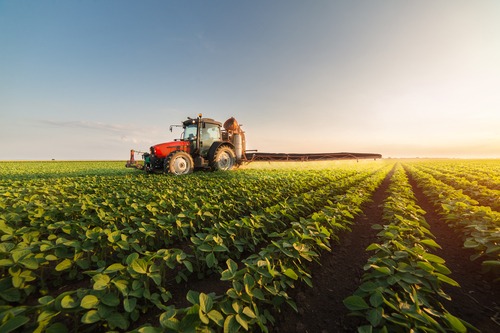Post-Pandemic Market Pushes U.S. Farmland Valuations to Fresh All-Time Highs
According to data compiled by the U.S. Agriculture Department, farmland valuations in the United States have climbed to an average of $3,800/acre in 2022, which is the highest on record

The “everything rally” has fallen to pieces in 2022, but some pockets of the financial markets are still trading near all-time highs—at least for now.
According to data compiled by the U.S. Agriculture Department, farmland valuations in the United States have climbed to an average of $3,800/acre, which is the highest on record. That figure encompasses an average price of $5,050/acre for cropland, and an average price of $1,650/acre for pastureland.
While farmland may not be the sexiest asset class on earth, it’s certainly one of the oldest. Records show that the Shirley Plantation in Charles City, Virginia was founded in 1613, and has been operating since 1638—making it one of the oldest documented farms in the country.
Appreciation in farmland prices certainly isn’t a new trend. From 1999 to 2019, data shows that cropland prices increased by about 4.4% per year—from roughly $2,400/acre to $4,400/acre during that span (national average). As mentioned previously, the national average for cropland today is just over $5,000/acre.
Much like other asset classes, the “everything rally” appears to have catalyzed a stronger-than-usual spike in farmland prices during the last couple of years—particularly the 12.4% jump from 2021 to 2022. Experts attribute this rapid increase to low interest rates, a robust housing market and an unusual abundance of government subsidies.
Farmland valuations are of course closely linked to the broader real estate market. When urban areas expand (via new housing starts), that typically puts more pressure on the prices of farmland located adjacent to the towns or cities in question. That momentum also tends to spill over into the broader farmland asset class.
Looking ahead into 2023, it’s likely that higher interest rates in the U.S. will serve as a strong headwind for farmland prices. Mortgage rates for 30-year fixed loans have been hovering in the 7% range, which is more than twice the level observed at the start of the year. Higher interest rates have been detrimental to the broader U.S. real estate sector, and will undoubtedly be a negative for farmland valuations, too.
One of the big x-factors in this particular asset class is the existence of government subsidies. Data shows that government subsidies peaked in 2020, when nearly 39% of farm net income (on average) was attributable to such subsidies.
That situation came about due to the trade war initiated by Former President Trump, which ultimately led to the distribution of $23 billion in funds by the Agriculture Department in 2018. Those subsidies were intended to assist farmers that were hurt by the trade war.
Farm subsidies provide an important backdrop for farmland prices, because land owners can use such payments as a type of safety net during downturns in the industry. That means during good times (i.e. high crop prices) land owners can book profits from their operations, and during bad times (i.e. low crop prices) they can make up financial shortfalls with government subsidies.
After peaking in 2020, the amount of farm net income attributable to subsidies has fallen back to earth. That figure fell to 20% in 2021, and is expected to drop below 10% in 2022—ostensibly because crop prices have been trading at the higher end of their historical ranges in the last couple of years. The chart below highlights recent trends in government farm subsidies.
Taken all together, it’s likely that farmland valuations will come under pressure in the coming months—not only as a result of higher rates, but also because government subsidies to the sector are dropping back toward their long-term averages.
Looking at the broader U.S. housing market, most forecasts suggest that prices could drop between 10% and 20% from the record highs observed in 2021. Under that scenario, farmland prices would almost certainly pull back from recent highs, too.
According FarmlandRiches.com, some of the largest farmland owners in the U.S. include the following individuals/families:
- Bill Gates (242,000 acres)
- Ted Turner (see below)
- Resnick Family (192,000 acres)
- Offutt Family (190,000 acres)
- Fanjul Family (152,000 acres)
- Boswell Family (150,000 acres)
- Stan Kroenke (124,000 acres)
- Gaylon Lawrence (115,000 acres)
- Simplot Family (82,500 acres)
- John Malone (100,000 acres)
Note, the above list denotes farmland owners specifically, not the overall largest landowners (in absolute terms).
The largest private landowners in the U.S. (accounting for all land types) are the Emmerson Family (2.33 million acres), John Malone (2.2 million acres), the Reed Family (2.1 million acres), Ted Turner (2.0 million acres), and Stan Kroenke (1.6 million acres).
To follow everything moving the markets during the remainder of 2022—including the U.S. real estate market—check out TASTYTRADE LIVE, weekdays from 7 a.m. to 4 p.m. CDT.
Sage Anderson is a pseudonym. He’s an experienced trader of equity derivatives and has managed volatility-based portfolios as a former prop trading firm employee. He’s not an employee of Luckbox, tastytrade or any affiliated companies. Readers can direct questions about this blog or other trading-related subjects, to support@luckboxmagazine.com.



















